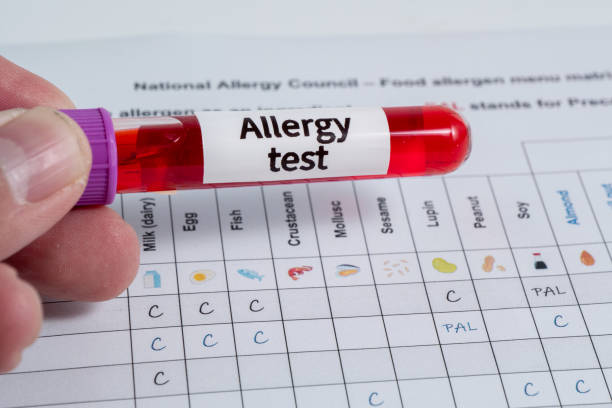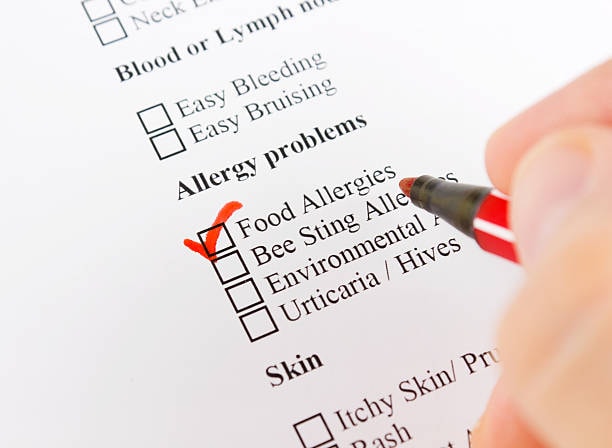
How to Read and Interpret Food Allergy Test Results: IgE Blood Tests Explained
Time to read 8 min
Time to read 8 min
Table of contents
Food allergy causes food allergy symptoms that can be life-threatening if not managed appropriately, especially in individuals with allergic diseases. Being aware of food allergy test results and understanding how to read and interpret food allergy test results helps you recognize the problematic foods and safe foods. It also helps you get rid of unnecessary dietary restrictions, allows better symptom management, and helps medical professionals create an efficient treatment plan.
There are different types of tests, and the main tests include IgE blood tests, skin prick tests, intradermal tests, oral food challenges, and diet elimination. So in this article, we will explore specific allergens, IgE tests, and food allergy test results, and how to read food allergy test results, so stay with us.
Here are the different types of food allergy tests that you should be aware of:
The specific IgE test measures allergen-specific IgE antibodies in the blood for certain foods or serum IgE levels. This type of allergy test is safe when skin tests are not possible. An IgE blood test is performed to recognize true allergic reactions that cause immediate reactions after eating the allergenic food. The common procedures include ELISA and RAST tests.
This type of blood test checks the levels of IgG antibodies in the blood. An IgG blood test is performed to diagnose delayed reactions and food sensitivities related to a food allergen that cause uncomfortable symptoms such as abdominal pain, bloating, headaches, and fatigue, usually hours after consuming the problem foods.
This type of allergy skin test is performed to recognize the allergen that is causing symptoms. It checks how you’re your skin responds to various substances. A small amount of allergen is applied or placed onto the skin, and the test site is pricked or scratched slightly. If a bump appears with redness within 15-30 minutes, it indicates a positive reaction, which confirms an allergic reaction. A skin test is a quick method to detect allergies.
This type of allergy test is performed to detect hidden allergies. The test involves injecting a small amount of allergen slightly deeper under the skin. Then the injection site is checked; if swelling and redness appear at the test site, it confirms the reaction. An intradermal test can diagnose strong allergies that a skin prick test may not.
The food allergy blood tests check for the food that is causing an allergic reaction by assessing the amount of IgE antibodies in the blood. The higher the IgE levels found in the blood, the stronger the possibility of allergy.
A small amount of blood is withdrawn from a vein in your arm for a sample.
The blood sample is tested using ELISA or RAST methods to check IgE levels against the allergen food.
This test recognizes the problem food that makes your immune system make higher levels of IgE antibodies. The more IgE antibodies found for a food, the stronger the possibility of allergy to that food.
The laboratory results are reported in kU/L or classes 0-6, indicating the degree of sensitivity.
IgE or Immunoglobulin E is an antibody produced by the immune system in response to harmful allergens such as some foods, dust, or pollens. The healthcare professionals measure IgE levels in the blood to understand how your body responds to certain allergens and allergic symptoms.
Here is the interpretation of high, normal, and low IgE results:
High IgE Levels: stronger possibility of an allergic reaction.
Normal IgE Levels: may or may not be an allergic reaction; results should match the symptoms.
Low IgE Levels: extremely mild or no allergic reaction.
Here’s the typical IgE Levels Ranges for your reference that may slightly vary depending on the laboratory:
Class |
IgE Levels (kU/L) |
Interpretation |
0 |
<0.35 |
Extremely mild or no allergy |
1 |
0.35-0.7 |
Low sensitivity |
2 |
0.7-3.5 |
Moderate sensitivity |
3 |
3.5-17.5 |
True allergy |
4 |
17.5-50 |
Strong allergy |
5 |
50-100 |
Stronger allergy |
6 |
>100 |
Extremely strong allergy |
Allergy blood test IgE levels results indicate how your body responds to certain allergens. The higher the amount, means stronger the allergies; however, your healthcare provider considers both the symptoms and the test results to confirm.
Your allergy test report is one side of the picture, not the complete picture. Understand how to read allergy test results, IgE, match with the clinical history and symptoms you are experiencing, and consult your allergy specialist or healthcare provider.
Learn about the test, for instance skin test and the intradermal test, a quick way to look for a skin reaction. While a blood test measures the antibodies.
Skin tests involve looking for the wheal sizes and locating the histamine (positive control) and saline (negative control).
Blood tests are about IgE values and classes for each food. The exact values may differ from lab to lab.
Look for the clinical correlation and match your test results with your symptoms. A positive test result with matched symptoms indicates the likelihood of a true allergy. A positive test result without matched symptoms may not be a clinical allergy.
Know the factors that can influence the food allergy test results, such as skin conditions, medications, and other health conditions.
Discuss your test results and symptoms with your healthcare provider; they may consider other factors as well, such as your medical history.
In case of confirmed and severe food allergies, carry the prescribed emergency medicines with you and follow the recommended action plan.
If you experience severe symptoms such as fainting and difficulty breathing after consuming the problematic food, seek emergency medical attention.
Thinking about how long it takes to get food allergy test results? How long do food allergy blood test results take is different from the skin tests. Here’s the typical waiting time for results from blood tests and skin tests.
Skin Allergy Tests: 15-30 minutes
Blood Allergy Tests: 2-5 days
The test turnaround times may be influenced by some factors, such as the type of test, how many allergens are being tested, the testing method, your location, the laboratory, and the sample transportation time to the diagnostic center.
Understanding and interpreting your food allergy test results is the prime factor in food allergy management and managing your allergies efficiently.
For a skin test, redness and a raised bump at the testing site.
For a blood test, a higher IgE level of antibodies to certain foods.
For the skin test, no appearance of redness or bumps at the testing site.
For a blood test, low or undetectable levels of IgE antibodies.
For the skin test, mild redness and a small wheal.
For a blood test, low IgE levels or class 1.
The food allergy test results should be discussed with a medical professional. A positive test is not the only factor to confirm a severe allergic reaction; similarly, a negative test is not always a confirmation of no reaction. Always consult your healthcare provider for an accurate diagnosis.
It shows how your immune system responds to a certain food, but not always associated with symptoms.
Some sensitivities or allergies, such as reactions to dust mites, may not be recognized through certain tests, so it is crucial to consider the symptoms.
Skin tests are more accurate for immediate reactions, such as those caused by animal dander, while blood tests are ideal for high-risk patients.
Some reactions may be due to intolerances or sensitivities that are not associated with the immune system.
Learning about your food allergy test results is essential to know the trigger foods, allergens causing reactions, and to get rid of unnecessary food restrictions. When you know how to read and interpret your food allergy test results, it allows you to make informed and efficient dietary and lifestyle choices.
Sometimes the allergy test results may look confusing and may not show you a clear picture. So consulting your healthcare provider can help you with that. They can match your test results with symptoms and recommend further steps. They can better explain what your test results mean and also create a tailored treatment plan for you.
Now you must be well aware of how to understand your IgE food allergy test results after reading the food allergy blood test results explained in this article. Book your allergy test with MyDiganostics today at a reasonable price, and consider following an elimination diet based on your results.
IgE levels can change over time due to various factors such as immune health, age, and environment. Usually, total IgE levels increase during childhood and decrease as you age.
Low IgE levels can be a concern as it is usually associated with a higher risk of autoimmune conditions, immune deficiencies, inflammatory diseases, and malignancies.
Most diagnostic centers in India, such as MyDiagnostics, offer home sample collection. Their trained medical professionals collect your sample from your home and then send it for analysis.
Both blood vs skin allergy tests are reliable in certain scenarios. However, the reliability of the test depends on the individual situation, severity of symptoms, medical history, and your healthcare professional’s assessment.
***Medical Disclaimer - The following information is for educational purposes only. No information provided on this website, including text, graphics, and images, is intended as a substitute for professional medical advice. Please consult with your doctor about specific medical advice about your condition(s).
